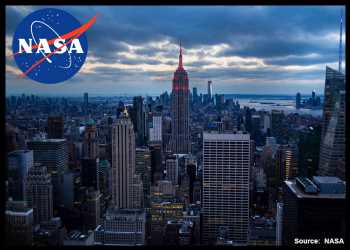Satellite To Map Air Pollution Over Haze-filled US Cities
As wildfire smoke blankets large parts of North America and summer haze due to severe heat reaching its seasonal peak, NASA and its partners are deploying several new tools to observe air quality and pollution in cities across the continent.
A satellite instrument launched into orbit earlier this spring will measure air quality over North America hourly during day and at the resolution of a few square miles, NASA said.
TEMPO, short for Tropospheric Emissions: Monitoring of Pollution, has a field of view that stretches from Mexico City to central Canada and from the Atlantic Ocean to the Pacific. NASA said that its new atmospheric chemistry instrument will soon begin transmitting data for scientific use.
Meanwhile, a separate NASA mission will complement the new satellite measurements with air quality observations from the field. The summer 2023 campaign includes a fleet of aircraft, mobile laboratories, weather balloons, and hundreds of scientists who have mobilized to track pollution in unprecedented detail. That mission, named Synergistic TEMPO Air Quality Science (STAQS), is examining the air in several populated North American cities including New York City, Chicago, Los Angeles, and Toronto.
The goal is to map air pollutants from the ground to the upper troposphere, track where they come from and how they change hour by hour, and identify neighborhoods disproportionately exposed to unhealthy air, according to the U.S. space agency.
“It’s the combination of satellite, airborne, and ground data that will help answer the fundamental question: what are we breathing?” said Barry Lefer, head of the Tropospheric Composition Program at NASA headquarters in Washington. “We can map inequalities like never before.”
One of the key pollutants the STAQS team and TEMPO will monitor is nitrogen dioxide, or NO2, which is commonly emitted by tailpipes and smokestacks and a key ingredient in ground-level ozone, or smog. The missions will also measure fine particulate matter, volatile organic compounds like formaldehyde, and methane and carbon dioxide, which are potent greenhouse gases that trap heat in Earth’s atmosphere.
The STAQS team isn’t operating alone. NOAA is leading the complementary AEROMMA field campaign to study air pollution this summer, one of several government and university-led efforts. With collaborators from more than 20 universities, several regional consortiums, state and local governments, plus NOAA, NASA, and other federal agencies, scientists are working together to “build a coast-to-coast air quality community that’s stronger than the sum of its parts,” Lefer said.
Laura Judd, associate program manager for Health and Air Quality Applications in NASA’s Applied Sciences Program, says regulations have led to significant reductions in harmful NO2 emissions and have slashed sulfur dioxide.
To enable that level of precision, her team is deploying two research aircraft equipped with remote sensors. It will be flown over the target cities to map pollutants. The goal is to better understand how factors such as traffic patterns and weather influence air quality at different times of the day.
Source: Read Full Article

